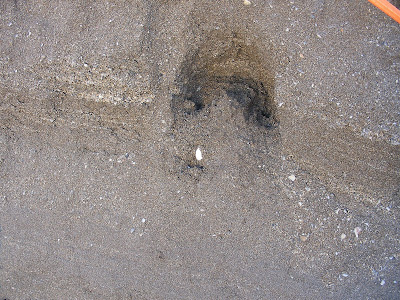
The chart shown is a photo (sorry about the glare!) of a poster at the Florida Oceanographic Society facility on A1A in Stuart, FL. As you can see, the "type" of turtle is identified with 2 letters ("CC") - in this case it would be a Loggerhead. Then the date the nest was laid (May 20). Next is the survey zone designation as per EAI and, finally, the identified stake's location relative to the nest (North). By the way, EAI stands for Ecological Associates, Inc., P.O. Box 405, Jensen Beach, FL 34958. They had educational materials concerning sea turtles that they shared last year. Their phone number is 772-334-3729. They are the organization that sends out employees each early morning to check the beaches for new nests. When they find new nests, they will stake them out (see photo) and post the pertinent data (see other photo) on one of the stakes to "rope off" the nest. They are also the only ones who can legally touch the nests, hatchlings, or other sea turtles that visit our beaches.













